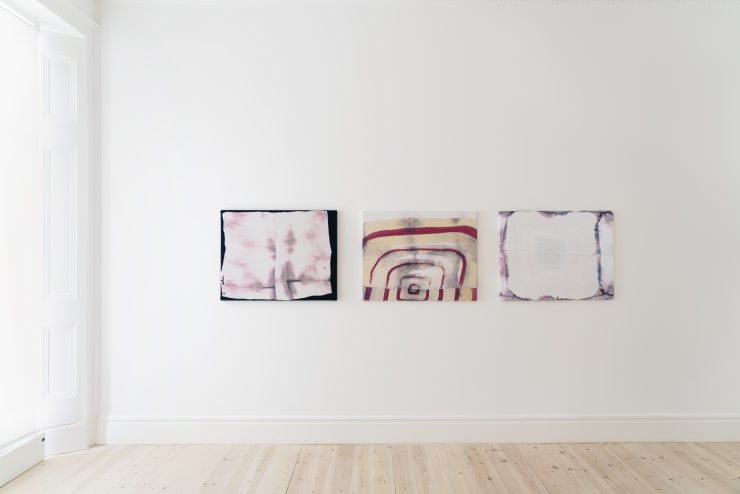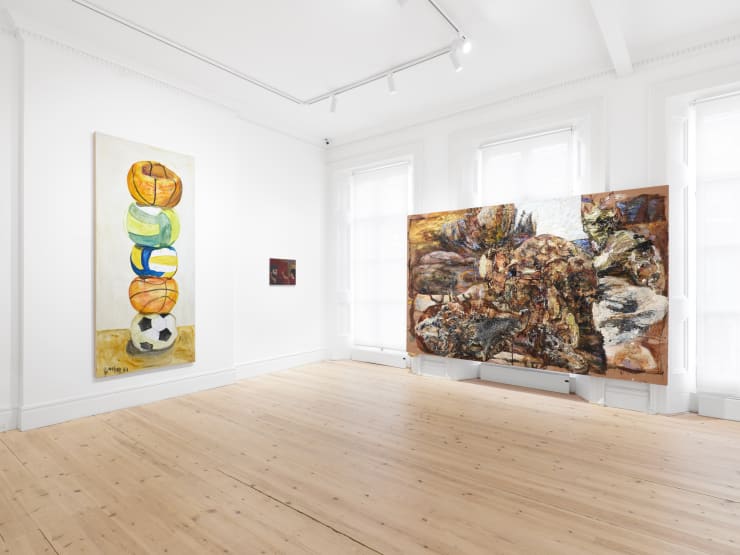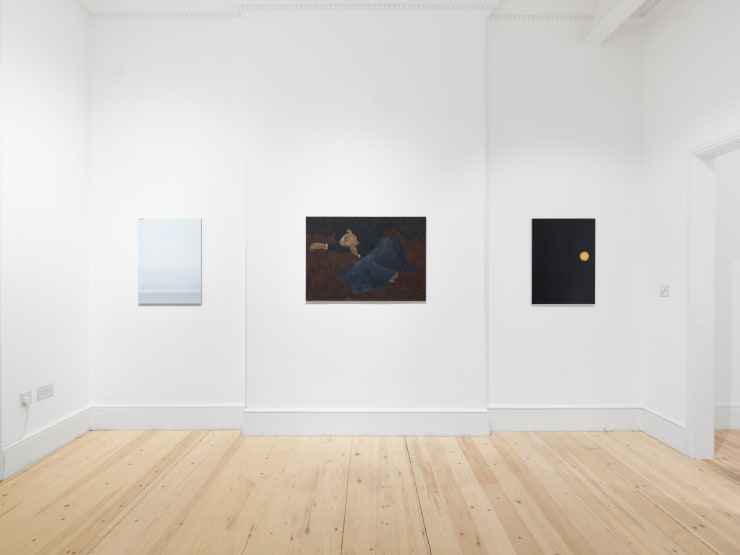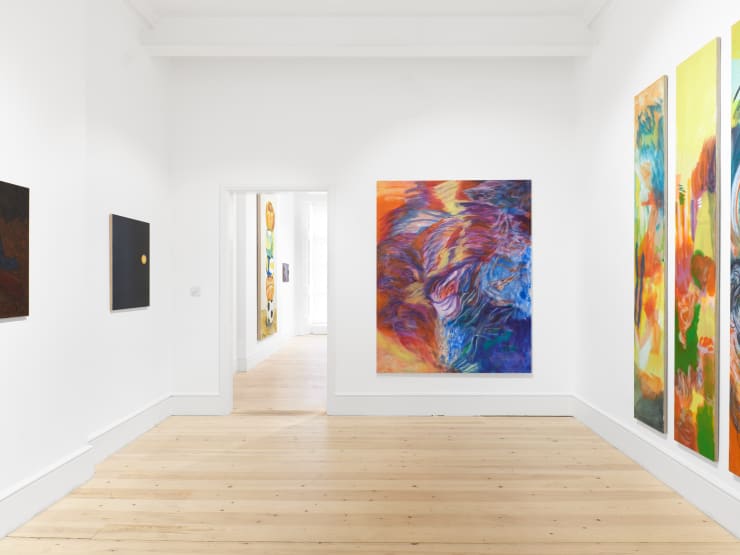Max Boyla, Zhang Enli, Michael Kvium, Ana Manso, Christian John Munks, Tahmina Negmat, Ricardo Passaporte, Gonçalo Preto: Silvers in the Void
Archive exhibition
Installation Views
Press release
Max Boyla, Zhang Enli, Michael Kvium, Ana Manso, Christian John Munks, Tahmina Negmat, Ricardo Passaporte, Gonçalo Preto, Sof ’ya Shpurova
Silvers in the Void
28 September–18 November 2023
MAMOTH is pleased to present Silvers In The Void, a group exhibition which includes works by Max Boyla, Zhang Enli, Michael Kvium, Ana Manso, Christian John Munks, Tahmina Negmat, Ricardo Passaporte, Gonçalo Preto and Sof ’ya Shpurova.
Cracked, hazy surfaces, quivering lines and coarse textures. These are among the qualities featured in works by nine international artists for MAMOTH’s latest group exhibition. While intercepting the reading of respective artworks, these same qualities open up visual portals that are teeming with allegory. Where symbolism and figuration are present, painterly innovation ignites it, facilitating multiple readings of the artworks present. From figuration to total abstraction, viewers are catapulted into the limbic space between real and imagined realms. Taking inspiration from daily surroundings, historical motifs and mythological symbols, and political narratives and belief systems, the artists in this exhibition use colour, material and form to distil the world’s complexities into arresting surfaces.
Scottish painter Max Boyla brings symbols and references into the expansive realm of abstraction, creating new pathways for imagination. In recent bodies of work he has turned to symbols of advertising and consumerism, using the illusory field of abstract painting to allow the ghosts of reality to unfold. Recently graduated from the Royal Academy Schools, Boyla’s paintings on view at MAMOTH contain hazy pools of sun-bleached ink, oil, silver paint, bleach, dye and rust on satin and velvet.
As when a word loses meaning through repetition, the singling out of objects allows Zhang Enli’s forms to teeter on the edges of abstraction. Born in Jilin province in 1965, the Shanghai-based artist incorporates brush handling specific to Chinese ink painting and calligraphy, which he learnt as a child, into oil-on-canvas paintings made up of dynamic, gestural lines of colour. In recent years, Zhang’s compositions have shifted from complete abstraction to representation of prosaic objects such as light-bulbs, buckets and balls, drawing out their essence through form and colour.
In Danish artist Michael Kvium’s canvases, the drama of human existence unfolds. Within his frames Kvium often picks recognisable stereotypes such as nuns, tourists and ballet dancers, frequently captured alone and wrapped in an air of disquietude. In the artist’s 2020 series Pale Male Tales, pallid and flabby male figures are captured wearing masks or in states of undress. Captured in solitude against flat planes of colour or striped backgrounds, the paintings subvert the power and bravado associated with masculinity and whiteness combined.
Portuguese artist Ana Manso’s paintings present charged and dynamic surfaces like the ever-changing colours of reflections on water. While Manso primarily uses oils, her paintings occasionally incorporate clay and techniques such as tie-dye or stencil, activating a further materiality to her compositions. The accumulation of matter begins with Manso’s stretching of her own canvases, which marks the start of her performative orchestration of gesture.
Based in Odense, Denmark, Christian John Munks creates paintings in soft, muted tones that draw from his memories and surroundings. Often working from photographs of individuals close to him, his paintings are rendered with oil paint and rabbit skin glue, which is often applied in multiple layers before painting. Munks never works from a sketch; instead, the paintings are revised layer by layer, until he arrives at a composition that delivers a specific atmosphere.
Using felt covered in fat, wax and thick oil paint, Tahmina Negmat describes her paintings as having the quality of being made in total darkness. Drawing on her personal experiences growing up in Uzbekistan and, later, in Russia, followed by the United Kingdom, these highly tactile works consider the absence of cultural reference points in a life on the move. As Negmat explains, ‘My artistic research aims to open up questions about the human condition when placed into the unnatural setting of unfamiliarity and the cultural biases that Western society may impose.’
Often combining spray-paint and acrylic, Ricardo Passaporte’s paintings contain references to popular imagery including cartoons and consumer branding and advertising, subverting the glossiness attributed to the latter with blurred, muted tones. A former graffiti artist, Passaporte is based in Lisbon, where he was born in 1987. Over the years, his paintings have absorbed the omnipresent logos of brands such as LIDL and Tesco, developing an airbrushed style that reflects humanity through the lens of consumerism.
Gonçalo Preto works with light to pull on the strings of nostalgia, inviting viewers into scenes characterised by a cool stillness. Born in Lisbon in 1991, where he currently lives and works, the artist has worked with explicit portrayals of light sources such as windows, which act as gateways to memory and reflection. Through dimmed reflections of light on interior walls, on the leaves of plants or a softly rendered plate of blood orange slices, Preto’s scenes are as banal as they are evocative, bringing forth the in-between moments of life.
Sof ’ya Shpurova describes her paintings as a form of ‘self-plagiarism’. Featuring herself or sometimes her partner, Shpurova’s paintings act as an inquiry into self-consciousness. With Russian origins, some of her work has adopted the stylistic qualities of icon painting. Mysticism too has found its way into her work, which also traverses ceramics, with the artist embracing the alchemical properties of the medium to create abstract objects that lack the figure present in her paintings.
Text by Tessa Moldan











